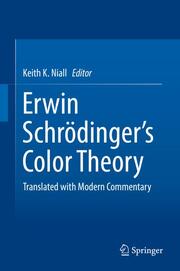Detailansicht
Erwin Schrödinger's Color Theory
Translated with Modern Commentary
ISBN/EAN: 9783319646190
Umbreit-Nr.: 2577500
Sprache:
Englisch
Umfang: x, 193 S., 27 s/w Illustr., 193 p. 27 illus.
Format in cm: 1.7 x 24.2 x 16
Einband:
gebundenes Buch
Erschienen am 20.12.2017
Auflage: 1/2018
- Zusatztext
- This book is the first complete translation of Erwin Schrödinger's work on colorimetry, of which he wrote about extensively (other versions from decades ago have appeared in partial and severely abridged form). He proposes that the geometry of color space is a projective geometry, rather than Euclidean. He also develops a dramatic conceptual shift in colorimetric methods, closely in detail and at length. Schrödinger concludes that the trichromatic (or Young-Helmholtz) theory of color and the opponent-process (or Hering) theory of color are really the same theory, or at least only trivially different. The resonance and importance of his bold concept of color space is emphasized for contemporary color theorists in this translation.
- Kurztext
- This book presents the most complete translation to date of Erwin Schrödinger's work on colorimetry. In his work Schrödinger proposed a projective geometry of color space, rather than a Euclidean line-element. He also proposed new (at the time) colorimetric methods - in detail and at length - which represented a dramatic conceptual shift in colorimetry. Schrödinger shows how the trichromatic (or Young-Helmholtz) theory of color and the opponent-process (or Hering) theory of color are formally the same theory, or at least only trivially different. These translations of Schrödinger's bold concepts for color space have a fresh resonance and importance for contemporary color theory.
- Autorenportrait
- Dr. Keith Niall is First Secretary for The Technical Cooperation Program at the Embassy of Canada in Washington, DC. He graduated from McGill University (Montreal, Canada) with a doctorate in psychology. He pursued postdoctoral studies in the experimental psychology of vision at Queen's University (Kingston, Ontario, Canada) and the Defence and Civil Institute of Environmental Medicine (Toronto, Ontario). He has been a scientist with Defence Research and Development Canada in Toronto since 1988. He was an exchange scientist to the US Air Force Research Laboratory's flight simulation facility in Mesa, Arizona. He has published widely in the study of human vision and visual displays.
